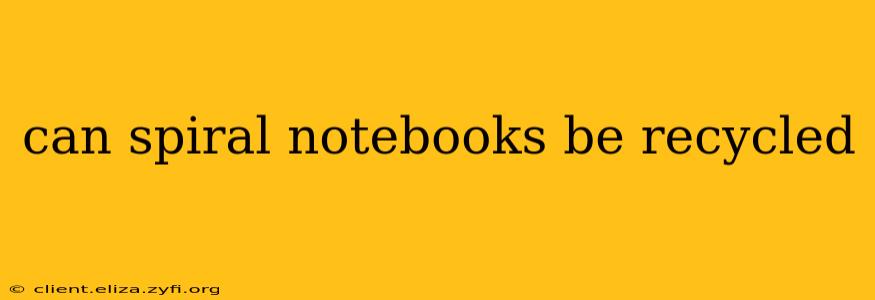Can Spiral Notebooks Be Recycled? The Comprehensive Guide
The question of whether spiral notebooks are recyclable is more nuanced than a simple yes or no. While the paper itself is generally recyclable, the presence of the spiral binding presents a significant challenge. Let's delve into the specifics.
What Makes Spiral Notebooks Difficult to Recycle?
The primary obstacle to recycling spiral notebooks is the spiral binding. This is typically made of metal (often steel or sometimes plastic) which cannot be easily separated from the paper during the standard recycling process. Mixing metal with paper contaminates the paper pulp, reducing its quality and making it unsuitable for creating new paper products.
Can I Recycle the Paper Portion of My Spiral Notebook?
Yes, in theory. If you're diligent, you can carefully remove the spiral binding yourself. This is a time-consuming process, requiring patience and potentially specialized tools to remove the wire or plastic coils. Once the binding is removed, you can recycle the paper components according to your local recycling guidelines.
However, even this isn't a guarantee of successful recycling. Many municipal recycling facilities have strict rules about paper contamination. Small pieces of metal or plastic left behind can still jeopardize the entire batch of recycled paper.
What About the Spiral Binding Itself?
The metal spiral binding itself is recyclable, but typically through a different process than paper recycling. Many scrap metal recycling centers accept metal spirals, but you'll need to separate them from the paper completely. Plastic spiral bindings are trickier; their recyclability depends heavily on your local facilities' capabilities and acceptance of plastic types.
How Can I Dispose of My Spiral Notebook Responsibly?
Here are some options for responsible disposal, depending on your resources and local recycling options:
-
Manual Separation and Recycling: If you have the time and patience, carefully remove the spiral binding and recycle the paper and metal separately. This method requires careful cleaning to remove any remnants of the binding from the paper.
-
Check with Your Local Recycling Facility: Contact your local recycling center to inquire about their acceptance of spiral notebooks or their specific guidelines on paper contamination. They can provide the most accurate and up-to-date information for your area.
-
Donation or Reuse: Before discarding your notebook, consider if it can be repurposed or donated. A notebook with some remaining pages can be used for note-taking, sketching, or other creative projects. Donating usable notebooks to schools or community organizations is also a good option.
-
Trash as a Last Resort: If all other options fail, the spiral notebook can be disposed of in the trash. This is, however, the least environmentally friendly choice.
What are some eco-friendly alternatives to spiral notebooks?
Considering the difficulty of recycling spiral notebooks, opting for more environmentally friendly alternatives can make a significant difference:
-
Loose-leaf binders: These allow you to replace only the used paper, reducing waste significantly.
-
Notebooks with glue bindings: Glue-bound notebooks are typically easier to recycle as they don't contain metal components. Check the manufacturing details to ensure the binding is truly glue-based and not incorporating plastic elements.
-
Digital note-taking: Using digital tools to take notes reduces the need for physical notebooks entirely.
Are there any special recycling programs for spiral notebooks?
Currently, there aren't widely available specialized recycling programs specifically designed for spiral notebooks. The challenges associated with separating the binding from the paper often make it impractical for large-scale recycling operations.
By carefully considering these factors and opting for environmentally friendly alternatives whenever possible, you can contribute to a more sustainable approach to note-taking and paper consumption.
